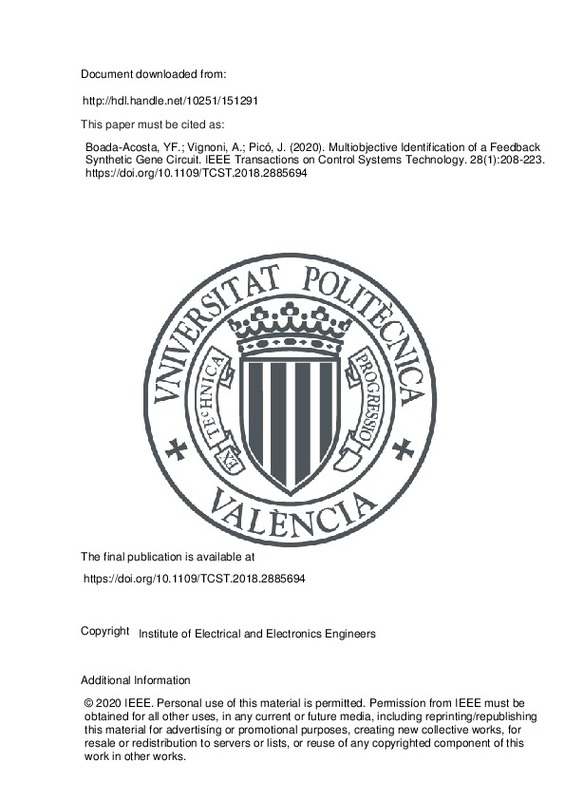JavaScript is disabled for your browser. Some features of this site may not work without it.
Buscar en RiuNet
Listar
Mi cuenta
Estadísticas
Ayuda RiuNet
Admin. UPV
Multiobjective Identification of a Feedback Synthetic Gene Circuit
Mostrar el registro sencillo del ítem
Ficheros en el ítem
| dc.contributor.author | Boada-Acosta, Yadira Fernanda
|
es_ES |
| dc.contributor.author | Vignoni, Alejandro
|
es_ES |
| dc.contributor.author | Picó, Jesús
|
es_ES |
| dc.date.accessioned | 2020-10-07T03:34:16Z | |
| dc.date.available | 2020-10-07T03:34:16Z | |
| dc.date.issued | 2020-01 | es_ES |
| dc.identifier.issn | 1063-6536 | es_ES |
| dc.identifier.uri | http://hdl.handle.net/10251/151291 | |
| dc.description | © 2020 IEEE. Personal use of this material is permitted. Permissíon from IEEE must be obtained for all other uses, in any current or future media, including reprinting/republishing this material for advertisíng or promotional purposes, creating new collective works, for resale or redistribution to servers or lists, or reuse of any copyrighted component of this work in other works. | es_ES |
| dc.description.abstract | [EN] Kinetic (i.e., dynamic) semimechanistic models based on the first principles are particularly important in systems and synthetic biology since they can explain and predict the functional behavior that emerges from the time-varying concentrations in cellular components. However, gene circuit models are nonlinear higher order ones and have a large number of parameters. In addition, experimental measurements are often scarce, and enough signal excitability for identification cannot always be achieved. These characteristics render the identification problem ill-posed, so most gene circuit models present incomplete parameter identifiability. Thus, parameter identification of typical biological models still appears as an open problem, where ensemble modeling approaches and multiobjective optimization arise as natural options. We address the problem of identifying the stochastic model of a closed-loop synthetic genetic circuit designed to minimize the gene expression noise. The model results from the feedback interaction between two subsystems. Besides incomplete parameter identifiability, the closed-loop dynamics cannot be directly identified due to the lack of enough input signal excitability. We apply a two-stage approach. First, the open-loop averaged time-course experimental data are used to identify a reduced-order stochastic model of the system direct chain. Then, closed-loop steady-state stochastic distributions are used to identify the remaining parameters in the feedback configuration. In both cases, multiobjective optimization is used to address the parameter identifiability, providing sets of parameters valid for different state-space regions. The methodology gives good identification results, provides clear guidelines on the effect of the parameters under different scenarios, and it is particularly useful for easily combining time-course population averaged and steady-state single-cell distribution experimental data. | es_ES |
| dc.description.sponsorship | This work was supported by the European Union and Spanish Government, MINECO/AEI/FEDER under Grant DPI2017-82896-C2-1-R. The work of Y. Boada was supported by the Universitat Politecnica de Valencia under Grant FPI/2013-3242. | es_ES |
| dc.language | Inglés | es_ES |
| dc.publisher | Institute of Electrical and Electronics Engineers | es_ES |
| dc.relation.ispartof | IEEE Transactions on Control Systems Technology | es_ES |
| dc.rights | Reserva de todos los derechos | es_ES |
| dc.subject | Closed-loop identification | es_ES |
| dc.subject | Feedback synthetic gene circuit | es_ES |
| dc.subject | Model reduction | es_ES |
| dc.subject | Multiobjective optimization | es_ES |
| dc.subject | Parameter identification | es_ES |
| dc.subject | Synthetic biology | es_ES |
| dc.subject.classification | INGENIERIA DE SISTEMAS Y AUTOMATICA | es_ES |
| dc.title | Multiobjective Identification of a Feedback Synthetic Gene Circuit | es_ES |
| dc.type | Artículo | es_ES |
| dc.identifier.doi | 10.1109/TCST.2018.2885694 | es_ES |
| dc.relation.projectID | info:eu-repo/grantAgreement/AEI/Plan Estatal de Investigación Científica y Técnica y de Innovación 2013-2016/DPI2017-82896-C2-1-R/ES/DISEÑO, CARACTERIZACION Y AJUSTE OPTIMO DE BIOCIRCUITOS SINTETICOS PARA BIOPRODUCCION CON CONTROL DE CARGA METABOLICA/ | es_ES |
| dc.relation.projectID | info:eu-repo/grantAgreement/UPV//FPI%2F2013-3242/ | es_ES |
| dc.rights.accessRights | Abierto | es_ES |
| dc.contributor.affiliation | Universitat Politècnica de València. Departamento de Ingeniería de Sistemas y Automática - Departament d'Enginyeria de Sistemes i Automàtica | es_ES |
| dc.description.bibliographicCitation | Boada-Acosta, YF.; Vignoni, A.; Picó, J. (2020). Multiobjective Identification of a Feedback Synthetic Gene Circuit. IEEE Transactions on Control Systems Technology. 28(1):208-223. https://doi.org/10.1109/TCST.2018.2885694 | es_ES |
| dc.description.accrualMethod | S | es_ES |
| dc.relation.publisherversion | https://doi.org/10.1109/TCST.2018.2885694 | es_ES |
| dc.description.upvformatpinicio | 208 | es_ES |
| dc.description.upvformatpfin | 223 | es_ES |
| dc.type.version | info:eu-repo/semantics/publishedVersion | es_ES |
| dc.description.volume | 28 | es_ES |
| dc.description.issue | 1 | es_ES |
| dc.relation.pasarela | S\398962 | es_ES |
| dc.contributor.funder | European Regional Development Fund | es_ES |
| dc.contributor.funder | Universitat Politècnica de València | es_ES |
| dc.contributor.funder | Agencia Estatal de Investigación | es_ES |







![[Cerrado]](/themes/UPV/images/candado.png)

